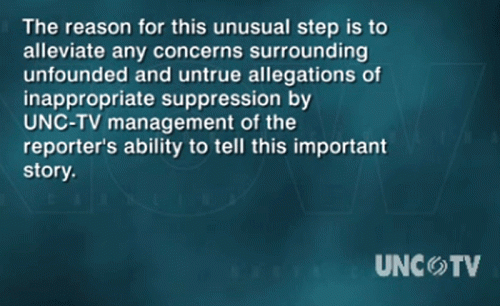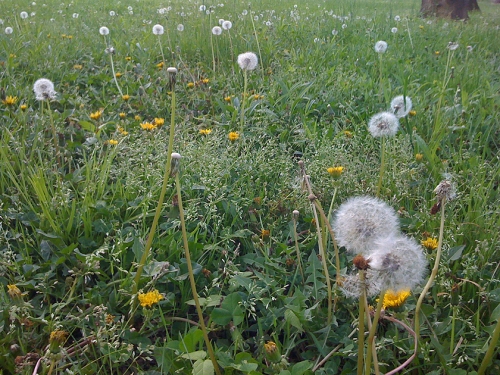
UNC-TV disclaimer on reporter's work about Alcoa

UNC-TV disclaimer2 on reporter's work about Alcoa
Here’s the disclaimer that ran on parts 2 and 3 of reporter Eszter Vajda’s series about Alcoa on UNC-TV.

UNC-TV disclaimer on reporter's work about Alcoa

UNC-TV disclaimer2 on reporter's work about Alcoa
Here’s the disclaimer that ran on parts 2 and 3 of reporter Eszter Vajda’s series about Alcoa on UNC-TV.

A view of Badin Lake from a back yard along its banks. The lake was created by Alcoa in 1917.
The next step in the Alcoa and UNC-TV saga became clear in a post by UNC public radio reporter Laura Leslie on Friday.
Alcoa wants to see all of the UNC TV reporter’s work.
UNC-TV recently complied with a subpoena from a legislative committee to share unaired footage from a story about Alcoa, an aluminum company that owns and operates dams along the Yadkin River and Badin Lake in North Carolina. The committee was pushing a bill to create a trust that could assume ownership of Alcoa’s assets along the river and lake. It settled for passage of a bill that created the Uwharrie Resources Commission, which can file lawsuits and lease or own property.
Immediately after the subpoena, the public TV station rushed onto the air a three-part report about environmental issues for plant workers and for surrounding land, along with a disclaimer saying the report was aired without its usual customary editorial review.
Leslie quotes the letter from Alcoa:
“Given the story’s inherent bias, the inclusion of undocumented claims against Alcoa, the fact that the segment aired with a disclaimer at the beginning and end acknowledging that for the first time ever the station abandoned its customary editorial review process, along with UNC-TV’s decision to permit Sen. Fletcher Hartsell to use its unpublished video as a blatant political tool, we want to learn more about how this story was developed and who influenced the content.”
Related: A lovely end-of-session note from UNC public radio’s Laura Leslie, paying tribute to her dwindling state-government reporting colleagues and giving credit to Twitter for helping the smaller cadre of reporters collaborate. It’s definitely worth a read and some thought on the future of reporting on N.C. state government.
Photo credit: Jack Lail, via Flickr.
Big hat tip to @binker, a statehouse reporter for the Greensboro News and Record, for rounding up reporters’ posts about the end of the session.
.
Also related:
Opinion from The Charlotte Observer’s Jack Betts: Where’s the bravery from UNC officials?
Raleigh News and Observer story on the public records request.
Background on possible utility companies interested in operating Alcoa’s dams from the Charlotte Business Journal
A bill that makes it easier for companies to get investments from private foundations passed the N.C. House on Friday and is expected to be signed by the governor.
It allows private foundations to give low-interest loans to L3Cs, or low-profit companies. The bill, S308, passed the N.C. Senate last year.
The new law has been envisioned by some as a way to boost domestic manufacturing like furniture making, and some see it as a way to save journalism or bolster news organizations.
It allows for-profit businesses to be organized to serve primarily charitable purposes. In the United Kingdom, they’ve been called profit-for-purpose businesses. One UK business, People-Centered Economic Development, was conceptualized in Chapel Hill in 1997.
Fast Company has quoted a foundation executive as describing the companies as for-profits with a nonprofit soul.
The Point Reyes Light weekly newspaper in California has been incorporated as an L3C under Vermont’s law.
The business model has been tossed around for symphonies, museums, yoga studios, family farm cooperatives and much more than just news organizations. Wikipedia explains better than I can.
Lots of background:
Davidson County Dispatch news story on the bill passage.
Sally Duros in The Huffington Post on L3Cs and how to save newspapers.
Save The News on L3Cs for news organizations.
Amy Gahran on L3Cs for news organizations.
Lydia Dishman in Fast Company describes L3Cs.
Big hat tip to @saduros on Twitter.

Charlotte Area News aggregator, from a Charlotte marketer
Local news creators have long had odd relationships with aggregators, who live off other people’s content but can drive some traffic back to the creators. The tension has often been framed as “local” versus “big national” companies.
But Buck Lawrimore, a longtime marketer in the Charlotte area, shows that the local versus national frame isn’t always valid. He has created Charlotte Area News, with some pages marked for niche local coverage at some point. Revenue appears to depend only on Google Ads, and content depends only on established media sources, available elsewhere.
The barriers to entry into this space are low: RSS feeds and freely available tools make setting up such a site fairly easy. In that respect, sites with successful business models will add value that no one else can: proper curation, care and feeding.
As one of the speakers at a news entrepreneur bootcamp at the Knight Digital Media Center said: After you create your business idea, build a moat. Your low barriers of entry will also be low barriers for competitors. Added value will ensure business success.
It’ll be interesting to watch the next moves in this space, and I’d love to see examples of other local sites across the country that do the same as Lawrimore’s. The Digitel in Charleston, a blended aggregator/creator, is on my radar. Also Chattarati, in Chattanooga, Tenn., from the ground up. Anyone else? Didn’t Asheville have an automated aggregator at one point? Is it still around?

Tunnel near downtown Charlotte.
I’ve always heard my city had historic gold mine shafts in unexpected places.
But some poking around online opened my eyes to some intriguing hidden spots with amazing visuals in my city, and the people who explore them.
This photo is from aurelie, created on Sept. 13, 2009, and shows a drain that resembles a mine shaft in urban Charlotte, about 2 miles away from downtown Charlotte’s shiny new office towers. There’s much more, from across North America, at Urban Exploration Resource.
In my media bubble, I had no idea there existed such a network of underground and up-high creators on blogs and forums, seeking adventure.
It’s a good reminder that not everyone is broadcasting on the big social networks and that niche communities are creating amazing content in their own hidden gardens.
Those gardens aren’t even walled; they’re just niche.
Smart information curators and journalists will keep in mind they exist, and turn around occasionally from the direction where everyone else is looking, to find unique, interesting content and perspective.
See more for yourself, at No Promise of Safety.

Dandelion weeds
Here are links to go with a presentation that looks at open education outside traditional institutions. The work was gathered for a class through Peer 2 Peer University, on digital journalism, taught remotely by Joi Ito, in the summer of 2010.
I dug into the subject after making a proposal to the Knight News Challenge for an open journalism class and pitching the idea at the Knight Digital Media Center’s news entrepreneur bootcamp in May 2010.
You can read more about that idea and free online journalism classes at a post by me at PBS MediaShift.
You can also see on Scribd one of the presentations created by a group of students in the class, covering the class.
On to links, many pointing to sites in the slides:
Nixty.com
Peer 2 Peer U
Hacks and Hackers
Mozilla Drumbeat and P2PU
Amazon site for “DIY U: Edupunks, Edupreneurs, and the Coming Transformation of Higher Education
Moodle
Open Study
List of similar endeavors to P2PU, compiled by P2PU’s Michel Bauwens.
Michel Bauwens’ Delicious links on learning.
My Delicious online learning links
Just three days ago, I started on a challenge to post three times a day here.
Now I’m acknowledging future failure, as I look forward to a short, full workweek ahead elsewhere.
So far, I’ve learned:
Posted in Uncategorized
UNC-TV has turned over unaired footage from reporting about Alcoa and the Yadkin River and its lakes to a state legislative committee to comply with a subpoena, according to WRAL.
Generally, journalists and their organizations in North Carolina have been protected from turning over unpublished material because of “shield laws.” In this case, UNC-TV’s lawyers said they were unsure whether the state shield laws would apply to an organization that falls under state control.
“We understand that there are those who will disagree with our decision, but given the legal uncertainty as to the application of the press shield law to UNC-TV, and because of the fact that UNC-TV is a state entity, we believe we have responded to this difficult situation in a manner that is legal, ethical and responsible,” said UNC-TV spokesman Steve Volstad.
Given some discussion for increased government spending and focus on public media, the event raises some intriguing questions.
Will sources feel comfortable talking with reporters for media under state or federal control, knowing all their information might be turned over to government agencies?
Should public media be structured in such a way that it does not fall under government control? UNC-TV employees are state employees and compelled by law to share requested information with the state legislature.
How can societies prevent state-run media from just becoming an investigative arm of government?
What journalists can and should do now: Read, bookmark and learn your states’ shield laws. The Reporters’ Committee for a Free Press has a shield-law guide.
Background:
Tuesday morning update from Observer associate editor Jack Betts, based in Raleigh. Includes a longer statement from UNC TV spokesman Steve Volstad.
Opinion from Jack Betts
Archives from the Raleigh News and Observer on Alcoa
Capitol Beat, the association of capitol reporters and editors, sends official letter objecting to subpoena.
Carolina Journal, the monthly newspaper of the John Locke Foundation, on the issue.
Photo credit: Jack Lail, licensed under Creative Commons. Badin Lake was created in 1917 by Alcoa.
Posted in Extras, Media business, Politics
Tagged journalism, media, media law, P2PU
Classmates Richard Smart (@Tokyorich) and Rick Martin (@1rick) collaborated on multimedia coverage of a protest in Shinjuku, Japan, against U.S. military bases on the Fourth of July. The work was part of an assignment in online journalism for a class at Peer 2 Peer University.
As the United States celebrated its birthday with parades, fireworks and the honoring of fallen soldiers, seeing a protest against U.S. military presence in other sovereign countries added rich perspective.
I would have had no idea about the protest without the classmates’ coverage. In that respect, the power of a global journalism class is remarkable.
Posted in Extras
Tagged blogs, Center for Independent Media, citizen journalism, Citizen media, education, journalism, media, P2PU
Many people have been talking about the legacy media’s lack of using the word “torture” in recent years.
As we celebrate our country’s independence on a Sunday, I’m reminded of a brave sermon on torture from 2006, during the height of silence.
Courage comes from unlikely places. Or perhaps not.